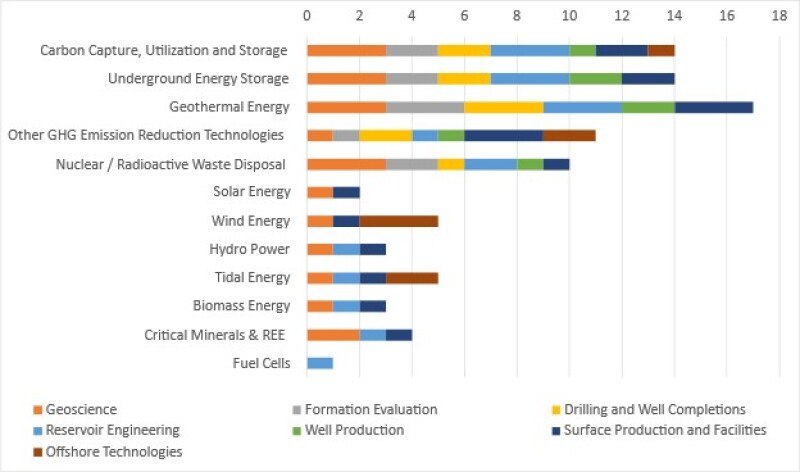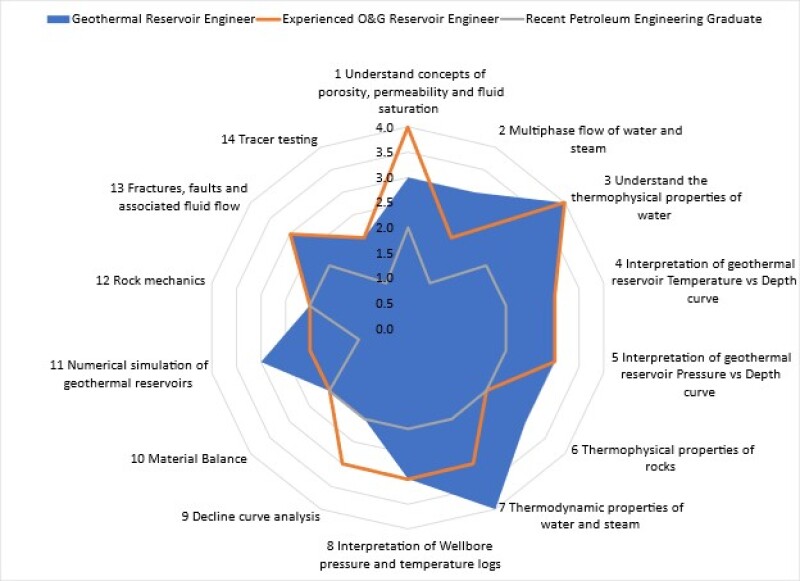Oil and Gas professionals of all ages, especially those early in their career, are increasingly questioning whether they have the skills required to sustain a long and successful career. Societal, environmental, and technological changes are having wide-sweeping impacts across our industry and the wider economy. In this article, we explore these changes and articulate how your technical background opens up diverse future opportunities inside and beyond the oil and gas industry. The need for life-long learning and professional development is more prevalent than ever, but even so, petroleum industry professionals have multiple avenues available for a long-lasting, vibrant, exciting, and rewarding career.
The Energy Transition Story
Over the past two centuries, the energy mix has evolved. Fossil fuels (coal, oil, and gas) have dominated the energy mix for over a century. However, fossil fuels are the largest single source of greenhouse gas (GHG) emissions. The energy transition is driven by the need to reduce GHG emissions to net-zero and utilize energy resources with minimal environmental and social impact. Thus, there has been a move towards increased integration of renewable energy and low-emission energy technologies. The BP Energy Outlook predicts deep penetration of renewable energy sources by 2050, with oil and gas still providing at least 30% of the energy mix.
Key Aspects of Low-Emission Energy Technologies and Sustainability
To prevent the worst impacts of climate change, GHG emissions must be reduced to net zero, and carbon must be drawn down from the atmosphere. There exist several decarbonization mechanisms. These include but are not limited to developing energy-efficient buildings and vehicles, energy conservation, changes in land use, fuel switching to wind, solar, biomass, and geothermal, direct air capture of CO2, and carbon capture, utilization, and storage (CCUS). Due to the seasonality or intermittency of most renewable energy resources, large-scale, intermediate-speed, and long-duration energy storage are required. Energy storage options include batteries, thermal, mechanical, or chemical systems such as hydrogen.
The advent of new energy sources and systems is rapidly increasing the demand for mineral resources such as lithium, nickel, cobalt, manganese, aluminum, copper, and graphite, which are crucial to battery performance, longevity, and energy density. Just like fossil fuels, these minerals need to be mined from the subsurface, are limited in quantity, and can only be found in limited geographical locations. So, although the energy source may differ, the dependency on non-renewable extracted resources is not eliminated but rather shifts. Each resource brings unique tradeoffs across the environmental, social, and political spectrum.
Where Do Petroleum and Geoscience Core Technical Skills Fit in the Energy Mix?
We are natural-resource engineers. Any technical role related to the finding, development, and management of natural resources has commonalities with conventional oil and gas industry roles. Many skills learned in technical and leadership career paths in the oil and gas industry are transferable to careers in other industries, including those focused on low-emissions technologies. Core technical petroleum and geoscience skills will remain relevant for decades to come, to different degrees. Figure 1 is taken from Okoroafor et al. (2022), where oil and gas competencies from technical disciplines of SPE’s competency matrices (SPE, 2022) were compared with the skills needed in low-emission energy technologies. The figure shows how different petroleum and geoscience domains (indicated by colors) fit into areas related to low-emission energy technologies (listed vertically). A domain with a bar width of 3 implies highly transferable skills. Fewer bars indicate less transferability.

Knowing how petroleum and geoscience skills fit in renewable energy and low-emissions technologies can provide insights for upskilling and reskilling. For instance, a petroleum engineer may desire to become a geothermal reservoir engineer. Figure 2 illustrates how a new graduate or experienced reservoir engineer’s areas of expertise map well to the requirements for a geothermal reservoir engineer
From Fig. 1, it can be seen that geoscience skills, reservoir engineering skills, and surface production and facilities skills cut across most of the low-carbon energy technologies. Geoscience skills from the oil and gas industry are utilized in geological and geostatistical modeling of subsurface structures, reserves estimation, understanding rock mechanics, geophysical imaging and interpretation, geochemistry and minerals processing, and remote sensing, to mention a few. These geoscience skills are strongly transferable to carbon storage, underground energy storage in geological media, nuclear and radioactive waste disposal, locating and mining critical minerals and rare earth elements, and geothermal energy. Reserves estimation, forecasting, and surveillance are relevant for pore space estimation for CO2 sequestration, hydrogen or compressed air storage, and geothermal heat capacity.

What About Non-Technical Oil and Gas Skills?
The transition to sustainable and renewable energy requires a robust set of non-core oil and gas competencies equally transferable across other industries. These competencies are relevant for ensuring business competitiveness and profitability for companies, understanding and fostering economic growth by government, and managing all stakeholders involved in promoting energy prosperity and environmental sustainability across the energy value chain. Table 1 below lists such non-core oil and gas competencies.
Table 1—Non-Core Oil and Gas Competencies Applicable in Other Industries
| Intrapreneurship | Health, Safety Security and Environment |
| Petroleum/Energy Risk-Weighted Economics | Business and Strategy Development |
| Uncertainty Analysis | Policies and Regulations |
| Project Management and Commissioning | Public and Government Affairs |
| Supply Chain | Legal |
| Logistics | Human Resources Management |
| Contract Management | Financial and Commercial Operations |
| Instrumentation and Controls | International Relations and Geopolitics |
| Rotating Equipment (including pumps, compressors and generators) | Media and Communication |
These skills and competencies cut across all aspects of low-emissions energy technologies and are easier to transfer from the oil and gas industry once an individual has the basics of what the low-emissions energy technology is all about.
Digital Transformation: An Enabler and Accelerator of Change
The energy transition is not the only systemic change underway that profoundly affects our careers. Digitalization is accelerating change in every aspect of our lives and our work.
Digital transformation results from the reduced cost, and so increased use of and reliance on bandwidth, sensors, data processing, and storage. The exponential growth of data storage capacity, ubiquitous sensors, the ability to scale data-processing capacity elastically, and step-change advances in artificial intelligence (AI) and machine learning (ML) are collectively creating new business models, hyper-automation, and workflow transformation. Digitalization changes everything from how we do our work, how we sell products, how we estimate sustainability impacts, how we communicate, and how we unlock value from natural resources. Multispectral imaging across space and time scales from satellite, aircraft, drones, and robots provides input to machine vision and GIS systems that can identify, attribute, and quantify issues from methane leaks to corrosion to equipment operational modes, and alert engineers or automatically trigger responses.
Information previously locked in documents, social media feeds, and disparate IT systems are being liberated, integrated, and utilized to identify opportunities and risks, and automate workflows. Blockchain, smart contracts, bitcoin, and distributed ledger technologies are creating more transparency into the life-cycle environmental impacts of products and services, and are creating new business opportunities fueled by more informed consumers, governments, and regulators.
Digital Twins are serving as the connective tissue to synthesize information across 3D models, simulations, real-time sensor analytics, vendor equipment diagrams, financial systems, activity and management of change tracking, and master data to create integrated, spatialized, virtual representations of assets, systems, and individual pieces of equipment. Virtual Reality enables personnel to train for complex jobs without traveling to the site. Augmented Reality overlays a person’s visual field with diagrams, training videos, and live feeds shared via virtual meetings porting in top technical expertise from anywhere in the world, and enables field personnel to perform an increasing number of specialized roles via over-the-shoulder coaching and virtual support.
All of the data captured can be processed to serve as input to powerful AI and ML algorithms, revealing insights not previously available. This creates novel opportunities for staff and leaders in our industry. People capable of identifying opportunities for digitalization who can articulate the value case, distill the core requirements and acceptance criteria, and lead the development of solutions optimized for their own use will be in great demand.
Data analytics, visualization, dashboard development, and robotic process automation are skills increasingly being adopted by oil and gas engineers to great effect. These capabilities are being employed to obtain real-time insights and optimize asset and supply chain operations, reduce emissions, environmental impact, and regulatory incidents, and eliminate repetitive, mundane work. Together, this makes our industry more competitive, safer, cleaner, more investable, and more enjoyable to work within. This also opens up many new avenues for professional development still focused on E&P workflows.
Main Takeaways
1. Many petroleum engineering and geoscience skills are transferable to areas like geothermal energy, underground energy storage (including hydrogen), CCUS, offshore wind, critical minerals, and rare earth elements.
2. Many common non-technical skills learned in the oil and gas industry are broadly transferable and greatly valued outside conventional upstream roles and across industries and sectors.
3. The petroleum engineer will also evolve as the energy mix evolves. New skills will become increasingly important, like driving production to net-zero by eliminating methane leaks and flaring, integrating renewables and storage for power generation, CCUS, energy storage, sustainability, and other related sustainable development concepts.
4. Engineers who understand how digital transformation can add bottom-line business value and can translate those requirements to teams who can develop solutions, or can develop solutions themselves, will create immense value, and as a result, will be in great demand.
References
bp. (2022). bp Energy Outlook: 2022 edition. bp Energy Economies.
IEA. (2017). Digitalisation and Energy.
IEA. (2021). The Role of Critical Minerals in Clean Energy Transitions. Paris: IEA.
Javaid, S. (2022, February 28). 5 Digital Technologies Transforming The Oil and Gas Sector in 2022. AI Multiple.
Okoroafor, E. R., Offor, C. P., and Ekeoma, I. P. (2022). Mapping Relevant Petroleum Engineering Skillsets for the Transition to Renewable Energy and Sustainable Energy. Accepted for presentation in SPE Nigeria Annual International Conference and Exhibition. Lagos, Nigeria, 1-3 August.
SPE. (2022, January). Competency Matrices.

